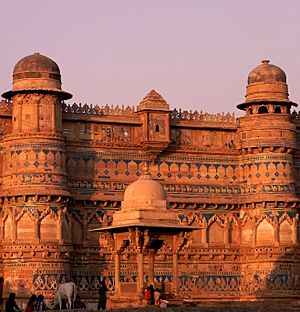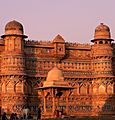95th (Derbyshire) Regiment of Foot facts for kids
Quick facts for kids 95th (Derbyshire) Regiment of Foot |
|
|---|---|

1856 photograph of three members of the 95th who fought in the Crimea: Sergeant John Geary, Thomas Onslow and Lance Corporal Patrick Carthay
|
|
| Active | 1823–1881 |
| Country | United Kingdom |
| Branch | British Army |
| Type | Line infantry |
| Size | One battalion |
| Garrison/HQ | Normanton Barracks, Derbyshire |
| Nickname(s) | The Nails |
| Engagements | Crimean War Indian Rebellion |
The 95th (Derbyshire) Regiment of Foot was a special group of soldiers, like a team, in the British Army. They were an infantry regiment, which means they were soldiers who fought on foot. This regiment was started in 1823. Later, in 1881, it joined with another regiment, the 45th (Nottinghamshire) (Sherwood Foresters) Regiment of Foot, to become part of the Sherwood Foresters. This change happened because of something called the Childers Reforms, which were new rules for the army.
Contents
History of the 95th Regiment

How the Regiment Started
The 95th Regiment of Foot was created by General Sir Colin Halkett on December 1, 1823. This happened because there was a worry about France getting involved in Spain.
The soldiers first traveled to Malta in March 1824. In December 1825, they were given a special name: the 95th (Derbyshire) Regiment of Foot. They then sailed to the Ionian Islands in January 1830. Their main base moved around a bit, from Corfu to Vido and back to Corfu, and even to Cephalonia. In December 1834, the regiment returned home.
Adventures in Asia
In October 1838, the regiment sailed to Ceylon. Their main base was first in Colombo, then moved to Kandy, and back to Colombo. While in Colombo, many soldiers got sick with cholera, and at least 63 died.
The regiment then moved to Hong Kong in March 1847. In 1848, nearly 40% of the soldiers got a bad fever. A company called Jardine Matheson helped them a lot, lending boats and arranging trips for the sick to get better. The regiment finally returned home in March 1850.
Fighting in the Crimean War
In March 1854, the regiment went to Turkey to fight in the Crimean War. They sailed to Kalamita Bay in September 1854. Soon after, they bravely moved forward under heavy fire at the Battle of Alma.
During this battle, the regiment lost many soldiers. Their special flag, called the Regimental Colours, was usually carried by a young officer. But because of the danger, a brave soldier named Private James Keenan grabbed it. He proudly placed it on the enemy's earthwork, called the Great Redoubt. The regiment lost about 20 officers and 180 other soldiers in this fight.
They faced more losses at the Battle of Inkerman in November 1854. Major John Champion, who was leading the regiment, was killed. The soldiers also fought in the Sevastopol during the winter of 1854. Many soldiers got sick or died from the extreme cold and diseases. People said, "there may be few of the 95th left but those few are as hard as nails." This is how they got their nickname, The Nails. The regiment returned home in June 1856.
The Indian Rebellion
In June 1857, the regiment sailed to the Cape of Good Hope. But just a few days after arriving in September 1857, they were sent to India. Their mission was to help stop the Indian Rebellion.
In January 1858, the regiment helped capture the town of Rowa. During this fight, Private Bernard McQuirt earned the Victoria Cross, a very brave award. They also took part in a small battle at Kotah-ke-Serai in June 1858, where a rebel leader, Rani of Jhansi, was killed.
Later that month, they helped recapture Gwalior. They also fought in several other battles during the Central Indian campaign. The regiment stayed in India until October 1870, when they sailed back to England.
Joining Other Regiments
In the 1870s, new army rules called the Cardwell Reforms came in. These rules linked single-battalion regiments together. The 95th was linked with the 54th (West Norfolk) Regiment of Foot. They shared a main base and recruiting area at Normanton Barracks in Derbyshire.
Then, on July 1, 1881, the Childers Reforms began. The 95th Regiment joined with the 45th (Nottinghamshire) (Sherwood Foresters) Regiment of Foot to form the Sherwood Foresters. This was the end of the 95th (Derbyshire) Regiment of Foot as a separate unit.
Important Battles and Awards
Battle Honours
These are special awards for battles the regiment fought bravely in:
- Alma
- Inkerman
- Sevastopol
- Central India
Victoria Cross Award
- Private Bernard McQuirt received the Victoria Cross for his bravery during the Indian Mutiny on January 6, 1858.
Images for kids





